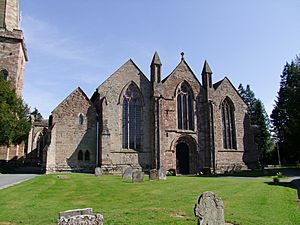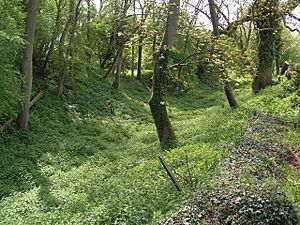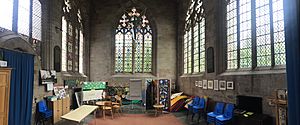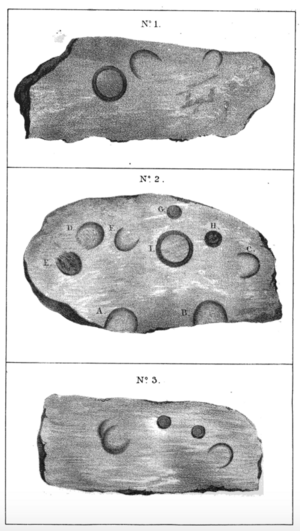Katherine of Ledbury facts for kids
Quick facts for kids Katherine of Ledbury |
|
|---|---|

St. Michael and All Angels Church in Ledbury, where Katherine lived as an anchoress or hermit.
|
|
| Anchoress, hermit | |
| Born | 1271 Brimpsfield, Gloucestershire, England |
| Residence | Ledbury, Herefordshire, England |
| Died | Sometime after 1326/7 |
| Major shrine | Possibly the Chapter House, St. Michael and All Angels Church, Ledbury, Herefordshire, England |
| Feast | 7 October (Diocese of Hereford); 25 November, derived from the earlier feast of Catherine of Alexandria |
| Attributes | ringing bells, the footprints of her stolen horse, clairvoyance, herbs and milk |
| Patronage | Ledbury, Herefordshire, England |
Katherine of Ledbury (also known as Katherine de Audley or St. Katherine of Ledbury; born 1272) was a Gloucestershire-born noblewoman of the 13th century who became an anchoress in Ledbury, Herefordshire. Although never officially canonized, Katherine was the subject of William Wordsworth's sonnet, “St. Catherine of Ledbury,” and is remembered as a patron saint of that town. She has often been confused with the 4th century martyr Catherine of Alexandria, whose cult in Ledbury preexisted hers.
Contents
Life

Katherine was born in 1271 in Brimpsfield, Gloucestershire, to John Giffard, 1st Baron Giffard, the owner of Brimpsfield Castle, and Maud de Longspée, a great-granddaughter of King John. In 1287 or 1288, when Katherine was 15 or 16 years old, she married Baron Nicholas de Audley and had two sons and a daughter, the first when she was 17 years old. After both her husband and her father died in 1299, she came into a large inheritance, including lands and property in Carmarthenshire, Shropshire, Staffordshire, and Cheshire.
She later became an anchoress in Ledbury. Various sources suggest she originally went missing on 25 February 1308, the day of King Edward II's coronation, before finally appearing in Ledbury as a recluse. The scholar Liz Herbert McAvoy has speculated that Katherine's disappearance and reappearance in Ledbury may have been an attempt to avoid being married to another lord after the death of her husband, which McAvoy claimed was common practice at that time. Indeed, McAvoy explained that Katherine must have been "one of the most desirable widows of the [Welsh border] region"; the fact that she didn't immediately remarry would have been unusual at the time, providing "fodder for a future mythologising of her life."
According to the antiquarian Rotha Mary Clay, Katherine gave away part of her maternal inheritance in 1312, and based on the location of the deed, it is likely she was already living in Ledbury and that the bishop had enclosed her as an anchoress in the church of St. Michael and All Angels. John Masefield clarified these claims, stating that in November 1308, Katherine had obtained a license to grant her dower-lands to her son Nicholas in return for an annual payment of £100 for her sustenance. Masefield concluded this may have been "her first step toward withdrawal from the world."
It is not known where Katherine lived between the death of her husband and her appearance in Ledbury. Masefield speculated she may have wandered, looking for a place to rest, as various legends suggest, or she may have taken up residence in one of her properties in Newport, Shropshire, or Llandovery, Carmarthenshire.
Other sources, however, have suggested that Katherine did not live at the farm but sent her maid there to fetch the milk she sometimes drank.
On October 7, 1313, Katherine granted her lands in Carmarthenshire to her daughter and son-in-law. Masefield concluded that at this time, she was living in Ledbury but was not yet a recluse. At some point between then and 1323, her life as an anchoress began: she was first referred to as a "recluse" on a deed dated 1323 in which she was allotted an annuity of £30 through the sheriff of Hereford, “the sums being paid,” according to Clay, “out of lands which were in the custody of her husband's executor.” Clay concluded that Katherine had made arrangements about her property in order to obtain a pension that would fund her life as an anchoress.
During the final years of Katherine's life, the source of funding that supported her anchoritic life was mismanaged, paid haphazardly, and sometimes fraudulently stolen, leading Liz Herbert McAvoy to wonder if she lived her final years as an anchoress in poverty, depending largely on alms from the Ledbury community.
Veneration
Legends
Legends have attributed clairvoyance and a miraculous power of prayer to Katherine. One Ledbury legend has it that Katherine chose to come to Ledbury because a vision had shown her she must not rest until she arrived at a place where the church bells rang unaided. According to Rotha Mary Clay, the legend narrates that Katherine and her maid Mabel “wandered from place to place, following out of Worcestershire into Herefordshire the hoof-marks of [Katherine's] mare which had been stolen.” The antiquarian Jabez Allies recounted that, in the version of the legend he'd heard, Katherine had prayed in response to the theft, and both the thief's footprints and the horse's hoof-prints had become "deeply indented, not only in the earth, but also in the stones wherever they trod." The antiquarian later drew a sketch of the supposed marks, which he claimed to have found in the sandstone rocks of Whelpley Brook in Herefordshire and which the locals called the "tracks of St. Catherine's Mare and Colt." He later claimed that local people also said the marks in the stones were a "representation of the loaves which Saint Catherine used to give to the poor." The stones themselves were for many years used by local people as charms or safeguards against robbery, and according to the Saturday Review, people continued to believe the story of Katherine and her mare into the early 19th century.
Having continued her journey and reached the village of Bosbury, Katherine heard the bells ringing and sent Mabel to identify the cause. She said she knew "she was to end her days at some place whose name terminated with bury." When Mabel returned and said the bells were being rung for a wedding, Katherine said this was not the place, and they continued on their journey. It was only upon reaching Ledbury that Katherine finally heard the church bells ringing of their own accord and decided to remain “under the shadow of the bell-tower” as an anchoress. After building a hermitage at the church, she was said to have lived on herbs and milk. The stone upon which Katherine was said to have been sitting when she heard the bells ring, and which was known by locals as Katherine's Stone, could for many years be seen in the area of land near the church known as Katherine's Acre before it was finally removed.
..... The Victorian author Compton Reade mentioned an account of Katherine's life in which she is described as a former "pious superintendent" of St. Katherine's Almshouses in Ledbury.
Cult
Katherine was never formally canonized but was known, according to John Masefield, as "a very good woman." There is, however, speculation that the Chapter House of St. Michael and All Angels Church in Ledbury was built as a shrine to Katherine.
The Diocese of Hereford celebrates a memorial of Katherine on October 7 (the day Katherine dispossessed herself of her properties in preparation to become a recluse). The Encyclopædia Britannica Eleventh Edition has also mentioned the following feast day of a "St Catherine Audley": "In Celtic and English martyrologies (November 25) there is also commemorated St Catherine Audley (c. 1400), a recluse of Ledbury, Hereford, who was reputed for piety and clairvoyance." Masefield, however, attributed the existence of this feast day, which he said was mentioned in a book of English saints, to a confusion of Katherine with Catherine of Alexandria, whose much earlier attested feast day is also November 25.
Rotha Mary Clay has suggested that Katherine's sainthood came about as a result of confusion between her identity and that of the earlier Catherine, for whom a chapel, hospital, and almshouse in the town were named many years before Katherine de Audley was born. Masefield has conjectured that Katherine may even have been named after the original St. Catherine, "from being born on her Day, or from some vow or other devotion that her parents had made or felt."
Liz Herbert McAvoy has emphasized the "correlation between these two women [St. Catherine of Alexandria and Katherine de Audley] in the popular imagination," a correlation she ascribes to the fact that the life of St. Catherine was "deemed eminently suitable for the instruction of young women considering religious enclosure" and that Katherine de Audley was herself enclosed "less than 100 metres from the powerful establishment [St. Katherine's Hospital] devoted to her saintly namesake."
See also



